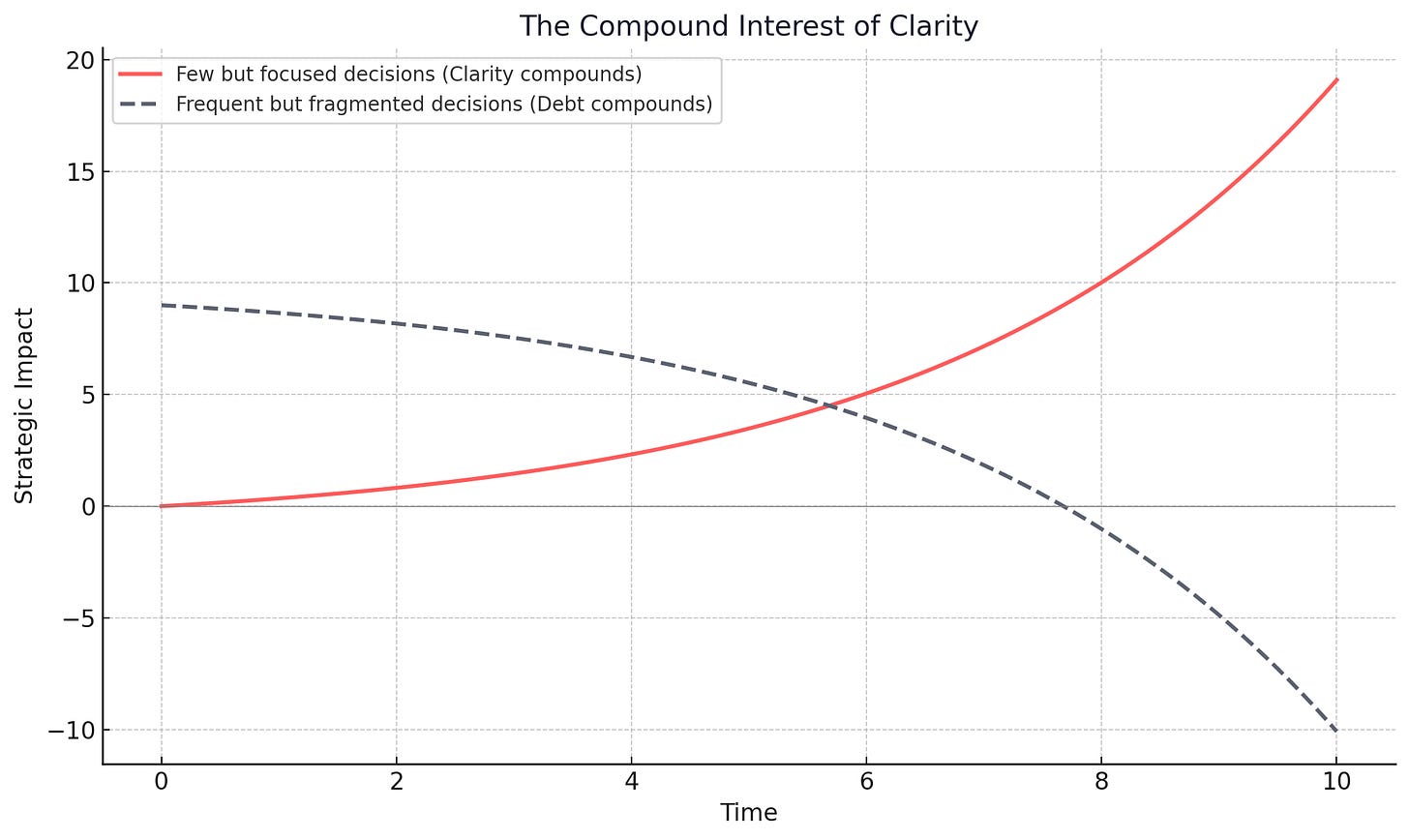Product Debt: The Hidden Cost of Saying Yes Too Often
How good intentions, quick wins, and polite “yeses” quietly overload your roadmap, dilute your strategy, and slow your product down.
🎧 Now a Podcast Conversation
This post led to a new episode of The Product Leader’s Playbook, where our AI hosts unpack what happens when your product accumulates quiet complexity through unchecked “yeses.”
→ 🎙 Listen on Spotify | Listen on Apple Podcasts
“Things which matter most must never be at the mercy of things which matter least.”
— Johann Wolfgang von Goethe]
What happens when you stop saying no?
Not all at once. Quietly, subtly, your product starts to drift.
A small feature gets added to keep a stakeholder happy. A one-off customer request becomes part of the core experience. A low-effort idea gets shipped because it’s “just a toggle.”
Each decision feels reasonable in the moment. Helpful, even. But over time, the weight adds up. The product feels slower. The purpose gets fuzzier. The team loses clarity.
This is product debt. Most teams don’t realize they’re carrying it until it’s already constraining what they can build next.
In my last article, The Validation Gap, I explored how teams confuse early excitement for real evidence. Product Debt is the next step in that conversation. It’s what happens when we build on that premature signal, stack up half-validated features, and keep saying yes because saying no feels like a blocker.
But every “yes” has a cost.
And too many unexamined yeses can bankrupt your strategy.
🧱 What Is Product Debt?
Most PMs understand technical debt: short-term tradeoffs in code quality that speed up delivery today at the cost of flexibility tomorrow.
But product debt is broader. It’s more dangerous because it’s harder to see.
It’s the bloat, the clutter, and the complexity that builds up when a product team prioritizes short-term progress over long-term clarity. It happens when ideas get greenlit without a strategy, when features stick around past their usefulness, and when the product grows horizontally instead of deeply.
Product debt shows up as:
Bloated scope that slows every release.
Fractured user experiences driven by internal silos.
Overlapping features solving the same problem, poorly.
Roadmaps that feel reactive instead of intentional.
A team unclear on what not to build.
Where tech debt makes your product harder to maintain, product debt makes your product harder to understand - for both your users and your team.
And if left unchecked, it shapes your entire trajectory. What you say yes to today becomes the surface area you’re stuck maintaining tomorrow.
Why It Happens
No one sets out to accumulate product debt.
It’s almost never a conscious choice. It’s a series of reasonable, polite, well-intentioned decisions:
“Let’s add it to the MVP. It’s a quick win.”
“They’re an important stakeholder. We should build this for them.”
“It’s not that much extra scope.”
“If it helps the sales team close, it’s worth it.”
Each of these sounds strategic. In practice, they often bypass strategy entirely. We say yes to avoid conflict. To keep velocity high. To be a “good partner.” And in the moment, the cost is invisible.
But here’s the catch:
Saying yes feels easy because the cost is deferred.
It’s not until months later, when the team is navigating edge cases, retrofitting UX, or trying to kill a feature they never should’ve shipped, that the true price becomes clear.
Common Causes of Product Debt:
Over-accommodation culture
PMs become conduits, not curators. Every voice gets heard, but nothing gets pruned.Weak prioritization frameworks
If everything is a priority, nothing is a priority.Unvalidated assumptions
Features built on shaky signal tend to linger, even when value isn’t proven.Fear of slowing down
Teams equate saying no with creating blockers. The real blockers come later.Stakeholder appeasement
Saying yes avoids friction. But it trades short-term harmony for long-term confusion.
The result? A roadmap full of features that were “easy to add” but are now hard to justify. A product that’s grown sideways, not forward. A team unsure how to reclaim clarity without a massive rewrite.
This is the quiet tax of always being agreeable.
📈 The Compound Interest of Clarity
Clarity doesn’t just pay off. It compounds.
The same way small savings grow into real wealth over time, a disciplined product strategy grows stronger with every small no.
Saying no doesn’t slow you down. It sharpens your momentum.
Each no protects your focus, preserves design integrity, and keeps your roadmap strategically constrained.
This is the core idea behind the Compound Interest of Clarity:
“Every small ‘no’ today creates room for a bigger ‘yes’ tomorrow.”
Just like compounding interest, the benefits build quietly at first. Over time, they create exponential gains:
Clearer UX
Faster decision-making
Less rework
Easier onboarding
Stronger product narrative
Teams that actually know what success looks like
Meanwhile, product debt works in reverse. It compounds confusion:
More features = more paths = more complexity
More stakeholders to appease = slower iteration
More “small adds” = bigger support burden
More exceptions = harder to scale
You may not feel the cost immediately. But you’re paying interest on every “yes” that didn’t come from strategy.
🚧 Signs You’ve Accrued Product Debt
Product debt doesn’t show up in error logs. It shows up in confusion, hesitation, and misalignment. Most teams don’t realize they’re carrying it until something that should be simple becomes surprisingly hard.
Common signs:
Your team struggles to explain the product
If it takes five sentences, two caveats, and a whiteboard, it’s not clarity, it’s clutter.Your roadmap feels reactive
Features show up because they’re feasible, not because they’re foundational.You keep revisiting decisions
Reworking, relabeling, or deprecating recently shipped features? That’s a clarity gap.Customer feedback is scattered
“Good, but confusing” often means too much, not too little.Your metrics don’t tell a coherent story
If success is hard to define or spread across too many surfaces, your product lacks a strong center of gravity.New hires feel lost
When onboarding feels like decoding a patchwork of legacy logic, product debt is part of the architecture.
💡 A Quick Story: Hidden Debt Isn’t Always in the Product
In one role, I realized we were working with three different vendors for a set of related services - each with its own contract, pricing model, and accountability structure. It was the result of too many easy yeses over time. Everyone had been moving forward fast, but no one had paused to clean up the trail behind.
On paper, it looked fine. In reality, it was draining budget, fragmenting execution, and creating wildly different customer experiences depending on which vendor was handling the service.
Roadmap items were getting delayed, not because the team lacked ambition, but because the operational overhead had quietly become unsustainable.
To fix it, I led a vendor consolidation through an RFP process, renegotiated pricing, and bundled key deliverables into a unified scope of work. The result? We lowered costs and unlocked enough capacity to keep shipping new features on time, without adding headcount or making tradeoffs.
It was a good reminder that clarity compounds, even in operations.
One strategic no unlocked momentum we’d been missing.
That’s the thing about product debt. It’s not always in the code. Sometimes, it’s hiding in the way you’ve structured your resources. And the sooner you clean it up, the faster you move.
Escaping the Trap
Product debt is sneaky because it’s often built on good intentions. The feature was useful. The stakeholder was important. The request was small. But over time, those small, unstrategic yeses add up. They start making every future decision harder.
The good news? You can dig out. Here’s how:
Draw a Clean Line Back to Strategy
Use No as a Design Tool
Audit Your Roadmap Like a Budget
Make Debt Visible in Planning
Re-center the Team Around Clarity
“Product debt doesn’t just slow you down. It reshapes what your product is.”
What You Ship Is What You Become
Every yes adds weight.
Every no creates space.
If you want a focused, strategic product, you can’t say yes like an order taker.
You have to earn it. You have to decide what belongs, and what doesn’t.
Because product debt doesn’t just slow you down.
It reshapes what your product is.
🧭 Let’s Make This Practical
Product debt isn’t always obvious, until you stop moving the way you used to.
Here are a few questions to take back to your team:
What parts of our product exist because we said yes without asking why?
Where are we paying interest on past decisions that no longer serve us?
What’s one small “no” we could say this week that might unlock clarity down the line?
If you’ve faced product debt before, how did you dig out?
I’d love to hear what worked (and what didn’t).
🎯 Want to Go Deeper?
🎙 This article is discussed in a podcast episode of The Product Leader’s Playbook, streaming everywhere:
🔹 Spotify
🔹 Apple Podcasts
🔹 YouTube | Amazon Music






